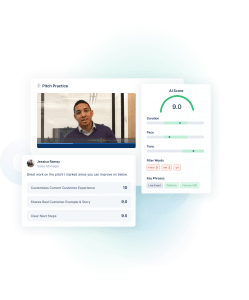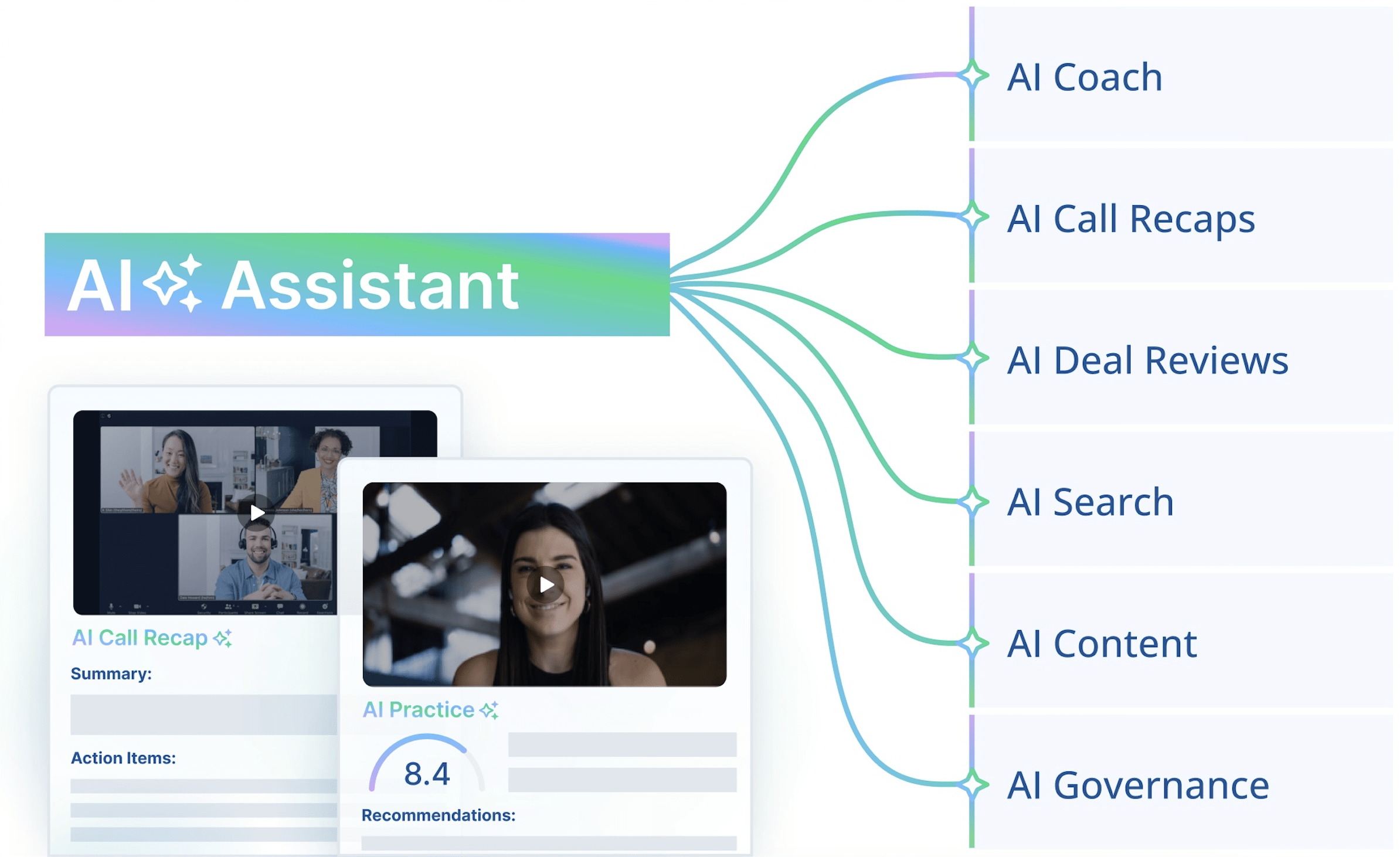Don’t give a sales pitch, have a sales conversation
Effective selling requires a language that is not native to most people, or at least doesn’t always come naturally. To complicate matters more, every organization has different dialects and vocabulary that are unique to its services, products, culture, and sales teams, so learning the selling language for one organization doesn’t necessarily mean a seller has mastered it for all. This is especially true for the sales pitch. Creating a good sales pitch at one organization doesn’t mean it will work for another. However, practicing and perfecting a good sales pitch teaches sales reps the overall skill of the ’sales language’ that can transfer organizations.
In this blog we breakdown the essential components you need to incorporate in your sales pitch practice and training program.
The road to a good sales pitch starts with immersion
Aaron Farley, a good friend and top enablement executive, shared with me his theory that immersion is critical to getting out of the cookie-cutter way of thinking about sales conversations and sales pitches as ‘a standard deck.’ The truth is, a good sales pitch uses effective sales language to have a natural conversation with a potential customer. The most effective way to learn how to do this is for sellers to immerse themselves in role-playing and feedback. Aaron also shared with me that a good example and reinforcement of this strategy are kids in high school or college who take advantage of traveling abroad or exchange programs. The kids who immerse themselves in Spain, Germany, Mexico, or France come back light years ahead of everyone else, simply because they were forced into meaningful conversations that involved real-life problems.
This is another important fact about immersion sales pitch practice and training – immersion in real-life situations makes sellers more responsive to customer stories in real life. It erases the “stop and internally translate” stage of the process, and instead empowers sellers to have a fluent conversation and provide solutions to the client’s problems in real time.
Some of the most effective sales pitch practice methods out there highlight the individual experience of both the customer and the seller. A good sales pitch isn’t something written down in stone, but an organic living thing that takes a life of its own. It includes components such as:
- Success stories
- Role-playing
- Problem-solving
- Matching product or service to a specific client problem
- Instantly giving past success examples and showing your problem-solving process at work
This is all done with the goal of achieving a sense of confidence and ease with the customer so the seller can maintain a natural, informative, and engaging conversation. It’s important to equip sales reps with all the sales tools they need when problems come up in a live discussion. This is a very steep learning curve, but it can be done!
Components of sales pitch practice and training
Sales onboarding is probably the most crucial time for a seller. Just like baby ducks, new sales hires imprint on the first thing they see. If you try to undo any training errors and neglect them later, it’s a thousand times harder than just easing them in right from the start.
The onboarding calendar is going to be your biggest ally when tackling this task – everything should be planned carefully, including time for e-learning and sales pitch practice, as well as an introduction to your sales library of content. You don’t want to just throw a bunch of links at new sellers and hope they stick, you want to give them time to review, understand, and comprehend what they are learning.
They need to know that it’s important and that an effective sales pitch requires knowledge and understanding that you can only get through getting excited about the material.
When you record a sales pitch at the very beginning of someone’s training, it’s a great idea to compare a later sales pitch practice once they get more experience out in the field. This is a good way of recording how a sales pitch can change with knowledge – maybe you’ll see some correlation or something that always tends to repeat? This way, you can adjust your training to make it more effective right from the start.
Sales pitch practice component 1: Take it seriously
There is a difference between a sales pitch presentation that’s on auto-pilot and a lively discussion about problem-solving. More often than not, one will result in relationship building, creative problem solving, and a strong sale – the other one not so much.
There is also a great difference between a strong sale and a passive sale. A strong sale forges a relationship, especially in a SaaS environment. The customer feels like they have an ally who understands their needs beyond an effective sales pitch. They will come back to your company for problem-solving and questions about the product instead of just ghosting you and eventually going to someone else.
To learn how to effectively formulate a strong sale that connects to a lively discussion that aids in helping the customer overcome challenges, sales pitch practice needs to be taken seriously. Too many sellers approach sales pitch practice as simply going through the motions to check it off the list.
Sales pitch practice component 2: Create pillars of sales enablement
This might sound confusing if you’re an architect or an engineer, but in the world of sales and non-construction businesses like SaaS companies, this makes perfect sense. In order to successfully lead a newly hired salesperson through your company’s values, best sales practices, and culture, you need to develop powerful pillars. They will help to support not only the onboarding process but every process going forward.
The pillars of sales enablement can be similar across many companies, but they can’t and shouldn’t be carbon copied because every business and sales ecosystem is different. In order to practice sales enablement well, you need to know what your sales environment is and make your pillars work organically with your company values, goals, and context. Some effective sales teams have as little as 3 or 4 pillars, while others sales teams have a longer list of sales enablement pillars. It all boils down to what you want to do with your structure combined with your company’s objectives.
Here is an example of sales enablement pillars by one of SalesHood’s clients:
- Ability to Articulate “Why Change”, “Why Now,” “Why Us”
- Exec Level Selling Abilities
- Powerful Prospector
- Skilled Account Planner
- Deep Discovery Skills
- Solution Expert
- Team Player
These pillars give a picture of someone who is knowledgeable, aggressive, and proactive with well-rehearsed abilities to problem-solve and have a meaningful conversation. At the top of the list is the Ability to Articulate “Why Us” – putting communication and knowledge at the very head of their sales enablement goals.
If you’re introducing sales enablement into a large company with hundreds of employees, one of the most important themes in your pillars should be communication and getting everyone on board with the program. These sales enablement pillars create a system to achieve this goal.
Your pillars will reflect who you are as an organization and what your values are and they are vital in helping you in creating a scorecard for grading sales pitch practice. What points should your sales team focus on? What should you excel at? The use of your best practices can be tracked through these scorecards when calls are “graded” by your leadership team. Scorecards may look something like:
- Introduction
- Customization of key findings
- Positioning Problem
- Positioning Solution
- Customer Proof Point
- Covered Next Steps
- Confidence
Here, again, we see that a big part of a company’s sales culture is all about knowledge and confidence. A winning culture happens when sellers are coached and graded on the confidence and presentation they put forward as well as the in-depth knowledge of the product or service they provide.
Sales pitch practice component 3: Feedback and leadership
Leadership is one of the most important factors in successful training and motivation for salespeople. Too often sellers are left to their own devices, with casual feedback from their immediate team leaders or management – being cut off from the bigger picture.
Having a CEO, COO, or CSO on board with the program makes the team members take the training seriously. Even if you have the most motivated people on board, they are going to be five times more motivated if they see that their work and sales pitch practice is getting reviewed in real-time.
Recording and capturing a sales pitch lets the top leaders in your organization see exactly what the clients see. This is an invaluable resource for the leadership in your company to step in and correct the course immediately. This positively affects the learning process and the investment that your sales team makes into sales pitch practice.
Remember that when establishing a great sales enablement and sales pitch training practice in your company, you can’t expect the sales team to hold themselves up – they need a call to action that’s shouted from the mountaintop by their leaders. Feedback, monitoring, and course changes are necessary to keep them motivated, competitive, and informed.
Companies like Confluent, Planview, RingCentral, Sage, and many others put an emphasis on real-time feedback and in-situation training – they have made it a part of their company culture. They use a feedback system to certify their reps and to have the best and most informed people on the front lines of their customer engagement and sales.
Sales pitch practice component 4: Create healthy competition and a positive learning environment
There’s something magical that happens when a competitive person knows that someone is evaluating their work – and even more so if the best work is going to get praise and recognition. All of a sudden, these people start producing some of their best sales pitches and conversations and making use of their resources. They master how to find good sales pitch examples and other resources easily and negate getting lost in piles of spreadsheets and brochures.
Why is that? Great leadership and great results start from the top – there is nothing better for motivation than being recognized and having your work appreciated. Having the company leaders “buy-in” into this training, and recognize its importance is key to building company culture and momentum. Leaders always set the pace. When your sales trainee gets immersed from the beginning and feels like they’re a key player – all eyes are on them and what they do matters, they learn it and they know it. It’s not like high school – “learn it, pass the test and forget it”.
When done from day one, this process builds conversational competence and results in a confident team from the very beginning and builds incredible muscle memory. Here are a few simple steps to follow:
- Use sales pitch practice in your onboarding, immediately prioritizing conversational competence from the start
- Make your elevator sales pitch start with a specific problem
- Include “behind the scenes” videos that go deep into explaining the relevance and the point of each training slide – this will give the trainee a unique inside look
- Use a coaching scorecard and make sure to grade your sales trainees on the aspects and best practices most important to you. The best way to decide which ones to highlight is to take a look at your sales enablement pillars again. Make sure that sales pitch practice is correlated with revenue outcomes
- Showcase top performers by crowdsourcing from your team – this will have a huge impact on sales pitch quality
- Provide localized content, sales pitch examples, and other resources for international teams
- Hold front-line sales managers responsible for providing feedback. This is one of the most important aspects of sales pitch practice and improving sales pitch effectiveness.
Sales pitch practice component 5: Working remotely and effectively
Working remotely has become part of the new normal. The sales teams that are benefiting most are the ones who have always had a portion of their sales teams working remotely, or a portionate hybrid workforce.
It used to be that remote sales teams were easy to neglect. The amount of effort that was put into managing them, even if it included frequent flying and in-person meetings just never seemed to be enough. Now that has all changed. Remote sellers are just as important as sellers who work in the office most days.
Sales pitch training should encompass aspects of both hybrid sellers and in-office sellers. It should not only be accessible to every seller, but it should make sellers more accessible to each other. Essentially, your sellers are all remote together. They can share personal stories and they can experience value firsthand – and see what works and what doesn’t in a team setting.
Role-playing during sales pitch practice will also bring to light individual problems that a rep might encounter. They might have something to do with their previous experience in sales, or with their personality traits. Keeping it custom helps every team member achieve their potential to the fullest extent.
It’s easy to “get in character” when all of your sales pitches are communicated remotely – the practice can take on a form that’s exactly the same as the actual salesperson-to-client interaction. There’s no better confidence-building tool.
Sales pitch practice component 6: Localize international teams
One of the most important aspects of making the international team’s sales pitch effective is providing them with localized resources in their sales enablement library. If there is a language barrier, make sure that your sales managers or team leaders who sit abroad have all the necessary materials in their own language, and that the sales pitch practice and sales pitch training is being delivered in the language the sellers will use with their customers.
Additionally, have a champion that knows the culture, language and can build a bridge of understanding between the top management and the sales reps in the field. The international team has to know that the language barrier isn’t really a barrier at all and a good sales pitch should be recognized across all of your sales teams, even if it needs to be translated.
The important part is making every seller experience custom. In a global setting, even if your product or service is the same, the customer problems might differ. Role-playing and practice problem-solving helps everyone involved understand what problems the sellers may face and helps to adjust in real-time.
This is especially true for sales team members who work remotely. Remember, this could also include sellers who are local but don’t come to the office. Anyone who doesn’t interact in person with the sales team on a daily basis is considered a remote worker in the new hybrid workforce. The number of hybrid workers across sales teams are growing so it’s critical that sales leaders accommodate sales pitch training and sales pitch practice to accommodate this new work style.
Sales pitch practice component 7: Build a sales content library
Being “hungry” has always been a word used to describe salespeople, and as an effective leader in the sales enablement process, you have to provide quite a feast of powerful, “just-in-time” content.
A good starting point is to collect success stories and case studies so your sales team knows they’re not starting from scratch. Sales is very much a practice that you pick up like a baton in a relay race, not a single-runner sprint. You have people behind you and you’ll have people in front of you.
The people behind you will learn from you, and you will learn from the people in front of you – shared experiences will become educational.
A great sales content library should include:
- Presentations
- Sales pitch practice sessions
- Case studies
- Customer stories and problems
- Sales decks
- Pitch examples
- Best practices
- Product information and playbooks
- Elevator pitch
- Win stories
- FAQs
- Industry trends and white papers
- Buyer personas
This is a long list, but when you make your sales content library well-organized and searchable, it will be your most effective resource.
A sales content library needs to have powerful material for your sales reps to build on, and it needs to be constantly replenished with fresh content from the front lines. This is important for not only training but being able to adjust your course efficiently. Recording your sales pitch practice and making it a part of your resource bank will improve sales team confidence.
Sales pitch practice component 8: Practice. Play. Adjust. Practice. Play. Repeat.
Once your team has completed sales pitch practice, honed their conversation skills, and had real-world situations with their sales pitch, it’s time to repeat the process. Why? Because now it’s time to take your work to the next level. Once your “students” have gained confidence in the process and in themselves through practice, gone out into the real world, it’s time for them to come back and build their own customer experience library to build on successes and failures.
Having a well-reviewed sales pitch practice regimen will immediately alert the leadership team if something is off, or not communicated enough. This will allow you to adjust course – in training, changing your scorecard requirements or reviewing the materials you have available in your content library.
Even if you run a large ship, it should be easy to turn around if you pinpoint your issues from the start and catch them before they grow.
The framework for a conversational elevator pitch
Finally, here’s a final last tip for you and your teams. What would you say when someone in business or in a social setting asks you what you do? How comfortable are you giving your elevator pitch? What would your teams say? What are you as a best practice framework? Here’s a proven framework you can use to improve your elevator pitch. It’s worked very well for us and our customers over the years.
- Problem: Start with a statement or question about the problem you solve and share eye-opening statistics. Answer the why.
- Value Statement: Share a very clear, concise statement of value. Be action-oriented and outcome focused. Avoid using jargon. Share benefits.
- How We Do It: Highlight unique differentiators and explain what you do.
- Proof Points: Provide clear reference examples and list out recognizable achievements. Share industry validation and awards.
- Customer Stories: Share customer examples and successes. Tell emotional and personalized customer stories. Make it real and tangible.
- Engaging Question: Close the pitch with an open-ended question creating a space to have a conversation.’
Pitch practice and Messaging Alignment At Scale
| If you’re interested in seeing innovative ways to get your teams practicing your pitch with an industry leading Revenue Enablement Platform, you can watch a demonstration and you can also request a consultative meeting. We’re here to help anyway we can. |  |



